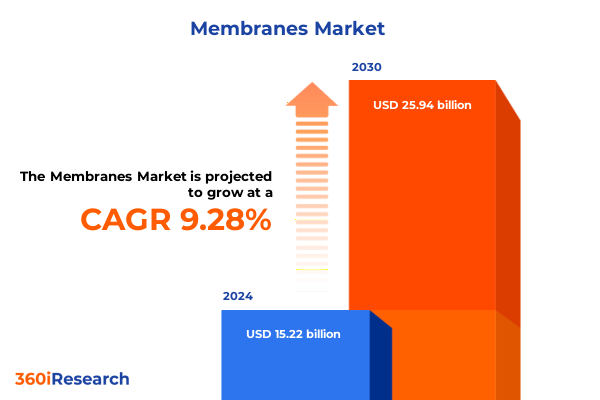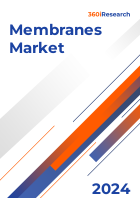The Membranes Market size was estimated at USD 15.22 billion in 2024 and expected to reach USD 16.69 billion in 2025, at a CAGR 9.28% to reach USD 25.94 billion by 2030.

Introduction: Exploring the Future of Membrane Technology
Membrane technology has emerged as a pivotal force across diverse industries, driven by innovative breakthroughs and evolving market demands. The rise in environmental concerns and the global push toward sustainable practices have further augmented the role of membranes in processes ranging from water purification to chemical processing. Recent advancements in material sciences and precision engineering have led to more efficient, durable, and cost-effective membrane solutions. Today, industry players are not only focusing on performance enhancement but also on designing systems that integrate seamlessly with the digital and automated frameworks of modern plants. This dynamic evolution highlights the importance of overarching market trends, technological progress, and application-based innovations that are collectively reshaping the landscape. The increasing demand for higher purity levels, energy efficiency, and reduced operational waste catalyzes an environment that continuously drives research and market consolidation. With these transformative elements at play, the membrane market has reached a stage where strategic collaborations between academia, technology innovators, and established enterprises are essential to unlocking further value. In essence, this introduction lays the groundwork for understanding how membrane technology is setting new paradigms in both industrial efficiency and environmental stewardship.
Transformative Shifts in the Landscape
The membranes market is undergoing significant shifts that are redefining traditional paradigms. Innovations in manufacturing processes, raw material enhancements, and an increasing focus on sustainability have combined to reshape the competitive environment. Today, breakthrough improvements in performance and efficiency have led to the development of membranes that are not only more durable but also smart enough to adapt to complex industrial demands. Market leaders are integrating new technologies that emphasize lower energy consumption and reduced waste, while regulatory pressures drive a faster pace of innovation. Early adopters of advanced fabrication methods are witnessing rapid market penetration and higher client retention, which further validates the transformative trajectory of the sector. Consequently, the industry is shifting from conventional, passive separation methods to proactive, technology-driven, and highly customized solutions. This transformation is being fueled by a confluence of research breakthroughs, heightened environmental demands, and economic imperatives that are encouraging both established and emerging companies to rethink their strategies. As the market evolves, stakeholders are increasingly focusing on the dual objectives of operational excellence and sustainable innovation, ensuring that every advancement translates into tangible performance benefits in real-world applications.
Key Segmentation Insights
A close examination of the market segmentation for membranes reveals a multi-dimensional structure, where analysis based on material type, technology, application, end-use industry, and design plays a pivotal role in understanding the evolving competitive landscape. From the perspective of material type, the market is dissected into ceramic, metal, and polymeric membranes, each category offering distinct advantages and challenges. Ceramic membranes, including subsets such as alumina, titania, and zirconia, stand out for their thermal and chemical stability. In contrast, metal membranes, particularly those based on stainless steel and titanium, are chosen for their robust performance in demanding environments, while polymeric membranes incorporate compounds like cellulose acetate, polysulfone, and polyvinylidene difluoride to offer enhanced flexibility and scalability for various industrial applications. Moving on to technology, the market is segmented into microfiltration, nanofiltration, reverse osmosis, and ultrafiltration. Notably, microfiltration is further refined into cross-flow and dead-end techniques; nanofiltration is segmented by control parameters such as constant flux control and variable retentate composition; reverse osmosis distinguishes between high-pressure and low-pressure modalities; and ultrafiltration is characterized by hollow fiber and tubular configurations. The segmentation based on application spans chemical processing, food and beverage, pharmaceutical and biotechnology, and water treatment, with each domain housing specialist methods – for instance, acid recovery and solvent dehydration in chemical processing, dairy processing and juice concentration in the food sector, protein separation and viral clearance in pharmaceuticals, and both drinking water and wastewater treatment in the water domain. Additionally, end-use industry segmentation divides the market into commercial, healthcare, industrial, and residential sectors, reflecting diverse needs from hotel and industrial kitchen operations to hospitals, research laboratories, and household water purification. Finally, the design segmentation categorizes membranes into capillary, flat plate, and spiral wound variants, each featuring sub-designs aimed at optimizing flow and efficiency. This comprehensive segmentation framework provides a strategic roadmap for stakeholders, enabling them to pinpoint lucrative opportunities and tailor their service offerings with pinpoint accuracy.
This comprehensive research report categorizes the Membranes market into clearly defined segments, providing a detailed analysis of emerging trends and precise revenue forecasts to support strategic decision-making.
- Material Type
- Technology
- Application
- End-Use Industry
- Design
Key Regional Insights
Across various geographies, regional trends are exerting a strong influence on market dynamics. In the Americas, the focus on advanced water treatment initiatives and stringent environmental regulations is fueling significant investments in next-generation membrane systems. Meanwhile, the Europe, Middle East & Africa region is witnessing rapid progress as policy frameworks emphasize sustainability and energy efficiency, prompting closer industry-academia collaborations and intensified R&D investments. In the Asia-Pacific region, the demand is being driven by industrial expansion and infrastructure development, with countries actively investing in modernizing their water treatment and chemical processing facilities. Each region presents its own unique blend of challenges and opportunities, characterized by differing regulatory landscapes, market maturity, and technological readiness. These regional nuances not only help in refining product offerings but also in tailoring marketing and operational strategies, thus ensuring that innovations and capital allocations are aligned with localized growth imperatives.
This comprehensive research report examines key regions that drive the evolution of the Membranes market, offering deep insights into regional trends, growth factors, and industry developments that are influencing market performance.
- Americas
- Asia-Pacific
- Europe, Middle East & Africa
Key Companies Insights
The competitive arena in the membranes market is populated by industry giants and innovative newcomers alike, each contributing their unique strengths to drive market evolution. Companies such as 3M Company, Applied Membranes, Inc., and Aquaporin A/S are at the forefront, leveraging extensive research and development capabilities to pioneer advanced membrane technologies. Global conglomerates like Asahi Kasei Corporation, BASF SE, and DuPont de Nemours, Inc. have utilized their diversified portfolios to integrate membrane solutions across varied industrial applications, thereby setting high benchmarks in material quality and performance. Filtration Group Company and General Electric Company combine scale with technological depth, enabling them to cater to complex industrial processes and rigorous quality standards. Alongside these players, specialized firms including Hyflux Ltd. and Ion Exchange (India) Limited have honed in on niche market segments to deliver tailored solutions. Further competitive differentiation is driven by companies such as Koch Separation Solutions, Lanxess AG, and Lenntech BV, which blend innovative product design with strategic partnerships. It is also noteworthy that organizations like LG Chem, Ltd., Menardi Filters, Merck KGaA, and Mitsubishi Chemical Corporation emphasize the importance of sustainable processes, while Nitto Denko Corporation, Novasep Holding SAS, and Osmotech Membranes Pvt. Ltd. continue to push the envelope in technological breakthroughs. Established leaders such as Pall Corporation, Parker-Hannifin Corporation, Pentair PLC, RM Nanotech, and Synder Filtration, Inc. solidify the industry’s growth trajectory with their progressive strategies. This diverse ecosystem, further supported by influential players such as The Dow Chemical Company, Toray Industries, Inc., and Xylem Inc., demonstrates an intricate balance of scale and specialization, which is essential for addressing complex global market demands and fortifying the industry's long-term resilience.
This comprehensive research report delivers an in-depth overview of the principal market players in the Membranes market, evaluating their market share, strategic initiatives, and competitive positioning to illuminate the factors shaping the competitive landscape.
- 3M Company
- Applied Membranes, Inc.
- Aquaporin A/S
- Asahi Kasei Corporation
- BASF SE
- DuPont de Nemours, Inc.
- Filtration Group Company
- General Electric Company
- Hyflux Ltd.
- Ion Exchange (India) Limited
- Koch Separation Solutions
- Lanxess AG
- Lenntech BV
- LG Chem, Ltd.
- Menardi Filters
- Merck KGaA
- Mitsubishi Chemical Corporation
- Nitto Denko Corporation
- Novasep Holding SAS
- Osmotech Membranes Pvt. Ltd.
- Pall Corporation
- Parker-Hannifin Corporation
- Pentair PLC
- RM Nanotech
- Synder Filtration, Inc.
- The Dow Chemical Company
- Toray Industries, Inc.
- Xylem Inc.
Actionable Recommendations for Industry Leaders
Industry leaders must adopt an approach that combines aggressive research and development with strategic alignment to future market demands. Stakeholders are encouraged to invest in advanced fabrication technologies and digital integration systems that enhance overall performance and operational efficiency. Emphasis should be placed on establishing strong partnerships across supply chain ecosystems and fostering cross-industry collaborations to accelerate innovation. In the wake of evolving environmental regulations and sensitivity to energy consumption, prioritizing sustainable materials and production processes is paramount. By focusing on modular designs that allow for upgradeability and customization, companies can remain agile in a rapidly transforming market landscape. Additionally, leveraging real-time data analytics and predictive maintenance protocols will not only help in reducing downtime but also in optimizing cost structures. These actionable insights pave the way for robust product development strategies and competitive differentiation in a market that is increasingly driven by technological precision and sustainability.
Explore AI-driven insights for the Membranes market with ResearchAI on our online platform, providing deeper, data-backed market analysis.
Ask ResearchAI anything
World's First Innovative Al for Market Research
Conclusion and Future Outlook
In summary, the membrane market is at a crucial inflection point, characterized by a blend of technological innovation, strategic segmentation, and regional dynamism. The robust growth stems from offerings spanning a diverse range of material types, technologies, and applications, all of which underscore the necessity for precise market positioning. As companies continue to invest in sustainable processes and advanced digital integration, the outlook remains positive with steady demand growth across multiple sectors. The synthesis of comprehensive market segmentation, innovative design trends, and strategic regional insights reflects an industry eager to navigate complex challenges while seizing new opportunities. This analysis also highlights the importance of dynamic leadership and the agility to adapt in a fast-paced market environment, ensuring that all stakeholders are well-prepared to capitalize on emerging trends in membrane technology.
This section provides a structured overview of the report, outlining key chapters and topics covered for easy reference in our Membranes market comprehensive research report.
- Preface
- Research Methodology
- Executive Summary
- Market Overview
- Market Insights
- Cumulative Impact of United States Tariffs 2025
- Membranes Market, by Material Type
- Membranes Market, by Technology
- Membranes Market, by Application
- Membranes Market, by End-Use Industry
- Membranes Market, by Design
- Americas Membranes Market
- Asia-Pacific Membranes Market
- Europe, Middle East & Africa Membranes Market
- Competitive Landscape
- ResearchAI
- ResearchStatistics
- ResearchContact
- ResearchArticle
- Appendix
- List of Figures [Total: 26]
- List of Tables [Total: 1034 ]
Contact Ketan Rohom for Your Comprehensive Market Report
To unlock detailed insights and a comprehensive analysis of the membrane market, we invite decision-makers to explore the latest market research report. With in-depth data, strategic evaluations, and forward-looking projections, this report is essential for driving informed business strategies. For further information and to secure your copy, please reach out to Ketan Rohom, Associate Director, Sales & Marketing. Your journey towards realizing future opportunities in the membrane sector begins with this critical resource.

- How big is the Membranes Market?
- What is the Membranes Market growth?
- When do I get the report?
- In what format does this report get delivered to me?
- How long has 360iResearch been around?
- What if I have a question about your reports?
- Can I share this report with my team?
- Can I use your research in my presentation?




